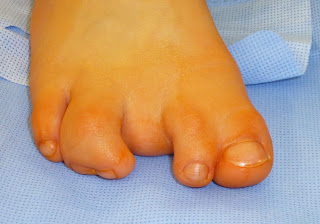Syndactyly, or abnormal joining of the digits, is most commonly considered to involve the hands. This is most likely for two reasons: hands matter more than feet to appearance and hands with syndactyly are more affected functionally than are feet with syndactyly. In most cases, syndactyly of the toes affects the 2nd and 3rd toes, and often is an incomplete syndactyly. However, occasionally a more significant syndactyly can exist in the feet.
Wikipedia, http://en.wikipedia.org/wiki/Webbed_toes notes several celebrities including Dan Aykroyd and Ashton Kutcher have toe syndactyly.
While I consider surgery for most cases of syndactyly of the hands, I feel that most cases of syndactyly of the feet can be treated without surgery. Again, the reason for this philosophy is that toe syndactyly is less problematic for appearance and function. Additionally, I have a greater concern for complications such as infection after toe syndactyly correction.
Nonetheless, in certain situations, toe syndactyly may be considered for surgical correction. For me, the most common reason to consider surgery is syndactyly affecting the great toe and second toe. This may affect gait and shoe wear. There are several medical publications on the topic of toe syndactyly including a recent technique description with excellent outcomes: http://www.ncbi.nlm.nih.gov/pubmed/20708986
Here I present a recent case of toe syndactyly with excellent early outcome.
 |
| Toe syndactyly affected great toe and second toe. The gap between the 2nd and 3rd toes also was a problem. |
 |
| Another view of toe syndactyly |
 |
| Surgical correction of toe syndactyly. The skin graft was harvested from the gap (which was narrowed). |
 |
| Final view of toe syndactyly corrected. |